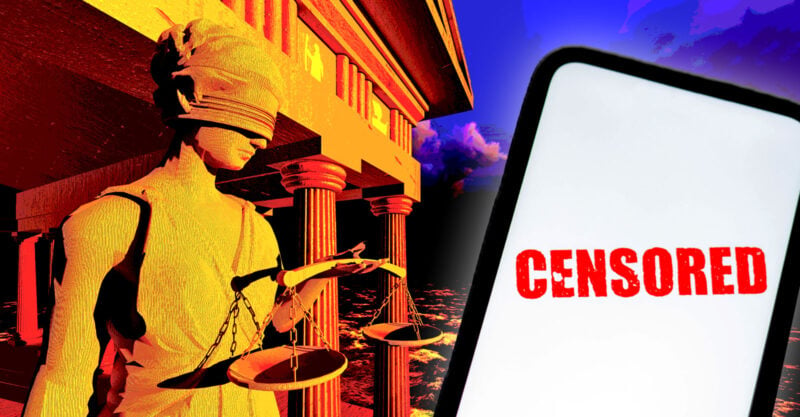Did Government ‘Coerce’ Tech Giants? Supreme Court Weighs Arguments in Landmark Censorship Case
The U.S. Supreme Court today heard arguments in a case that could determine if the U.S. government can legally pressure tech companies to remove content from social media platforms without violating the First Amendment.
Miss a day, miss a lot. Subscribe to The Defender's Top News of the Day. It's free.
The U.S. Supreme Court today heard arguments in a case that could determine if the U.S. government can legally pressure tech companies to remove content from social media platforms without violating the First Amendment.
The arguments pertained to a lawsuit filed in May 2022 by the attorneys general in Louisiana and Missouri, along with several social media users alleging President Joe Biden and other top administration officials “pressured and colluded” with social media companies to censor and suppress information, including posts that contradicted the official government narrative on COVID-19 origins, vaccines and treatments.
The question before the court is whether to uphold a preliminary injunction — issued on July 4, 2023, by a federal judge and largely upheld on appeal — barring several federal agencies and Biden administration officials from coercing, “significantly encouraging” or taking joint action concerning content moderation by social media companies until the lawsuit is decided.
Commenting on today’s arguments to free speech advocates gathered outside the courthouse today, Mary Holland, president of Children’s Health Defense (CHD), said, “I think that there was agreement that … it is absolutely a violation of the First Amendment for the government to coerce anyone to censor speech.”
However, according to Holland, an attorney who was inside the courthouse during arguments, the U.S. Department of Justice is arguing there was no coercion.
“To my mind, that’s absolutely absurd,” she said. “The government over many months with incredibly consistent phone calls and emails was telling the platforms to take down certain posts. So in my view, there’s no question that this was coercion.”
CHD and its founder and Chairman on Leave Robert F. Kennedy Jr. in March 2023 filed a class action lawsuit on behalf of all American news consumers against the Biden administration, making allegations similar to those made in Murthy v. Biden (formerly Missouri v. Biden). A federal judge in July 2023 consolidated the two lawsuits.
Plaintiffs in Kennedy et al. v. Biden et al. also requested and were granted a preliminary injunction by the same judge, Terry Doughty, prohibiting key Biden administration officials and agencies from coercing, significantly encouraging, or taking joint action with social media platforms to suppress or censor online content.
However, Judge Doughty simultaneously issued a stay on the injunction until 10 days after the Supreme Court rules in today’s case, which is expected to happen in mid-summer.
The outcome of the two cases could have wide-reaching implications for the First Amendment and online speech. The New York Times called Murthy v. Missouri one of “the most important First Amendment” cases of the internet age.
Plaintiffs allege censorship still ongoing
Today’s arguments in the Murthy v. Missouri case centered around whether the plaintiffs could show they were directly harmed by alleged censorship and whether such censorship of their social media posts could be traced to particular government actors.
Attorneys also debated whether the plaintiffs could demonstrate the Biden administration was coercing social media companies to censor disfavored speech rather than merely persuading them to do it.
U.S. Deputy Solicitor General Brian Fletcher told the court the plaintiffs have no right to sue — called standing — because they haven’t shown they face the imminent threat that the government will influence social media to moderate their posts in particular.
Plaintiffs’ attorney Solicitor General of Louisiana J. Benjamin Aguiñaga pointed out that plaintiff Jill Hines was still being censored as recently as April 2023, when Facebook warned her that an image she posted of a tweet by Kennedy violated community standards.
Kennedy was named several times during the hearing as the leading example of a person who was censored for expressing a disfavored viewpoint on COVID-19.
Fletcher also contended the White House’s communications with social media did not rise to the level of coercion. Instead, he argued they were merely using persuasion.
He also argued that the injunction was “extremely vague” and “overly broad,” because it extended to many parts of the administration and the federal government and suggested that if upheld it would infringe on the administration’s ability to use the “bully pulpit” to urge people to act in certain ways.
Aguiñaga argued to the contrary that the government exerted “unrelenting pressure” to “coerce social media platforms to suppress the speech of millions of Americans.”
Several justices said it was not uncommon for government actors to express their opinion about what was printed to the media. Justice Sonia Sotomayor said, “I mean this happens literally thousands of times a day in the federal government.”
Others, like Justice Brett Kavanaugh, questioned whether it was significant that the social media companies sometimes refused government requests.
Aguiñaga contended that this case was different from typical communication because government coercion caused the social media platforms to “routinely cave” to government demands.
Justice Samuel Alito made the case for what he saw as a unique relationship between the social media companies and the government that signaled undue government influence. In emails, he said the White House and federal officials are repeatedly saying the social media companies ought to be their “partners,” and “when they are unhappy, they curse them out.”
He said there are regular meetings and “constant pestering” of the platforms, along with suggestions for rule-setting. “I cannot imagine federal officials taking the approach to the print media.”
Aguiñaga maintained that the government is free to use the “bully pulpit,” to suggest platforms amplify its message.
“But the government has no right to persuade platforms to violate Americans’ constitutional rights and pressuring platforms in back rooms shielded from public view is not using the bully pulpit at all,” he said. “That’s just being a bully.”
He also pointed out that when the government uses the bully pulpit, or even when it reaches out to the press, it is a direct conversation between the two parties. In this case, he said “what’s so pernicious” is that the people being censored, like plaintiffs Hines and Jim Hoft, “have no idea what’s happening behind the scenes.”
Aguiñaga’s argument rested on the court’s decision in Norwood et al. v. Harrison et al., that the government cannot induce, encourage and promote private actors to do indirectly what the government itself can’t do directly.
Justice Ketanji Brown Jackson wondered if context, such as “a once-in-a-lifetime pandemic” might change the First Amendment principles.
Justice Jackson said she was worried that the case would have “the First Amendment hamstringing the government in significant ways in the most important time periods.” She argued the government has “a duty to take steps to protect the citizens of this country.”
Holland said the attorney for the plaintiffs argued that the point was not to stop the government from communicating, but that “the answer to speech is more speech. It’s not to censor people. What was happening here was the government suppressing independent voices on things about the election, on things about health, on things about COVID, on things about the lockdowns, and so on.”
Holland added:
“And in our view, the government cannot censor disfavored viewpoint speech. And they were specifically targeting speech that they disagreed with. It was a different viewpoint.”
Holland called the two-hour arguments “productive.” She said, “Every justice was involved, every single one. And I’m grateful for that. To be honest with you, I can’t tell you right now which way the court is going to rule.”
Corporate media paints case with partisan brush, plaintiffs disagree
For the most part, mainstream media cast the lawsuit as a partisan issue driven by Republicans that seeks to limit, for example, the U.S. Department of Homeland Security’s ability to flag content that “may be the work of foreign disinformation agents” or to circulate “misinformation” and “conspiracy theories.”
Plaintiffs and others — including CHD, in the amicus brief it filed on behalf of the Murthy v. Missouri plaintiffs — pointed out that much of the censored speech was actually true, that the administration sought to censor only particular people and viewpoints, and that the First Amendment protects people’s right to speak and to hear the political speech of others.
The lower courts affirmed the core accusation that the Biden administration likely violated the First Amendment when, in a “coordinated campaign,” it pressured social media platforms to remove content it considered “misinformation” about the COVID-19 pandemic, vaccines and other topics and temporarily limited its ability to do so.
The Biden administration appealed the ruling to the Supreme Court, arguing an injunction would prevent the government from talking to tech companies about matters of national security and from urging them to protect teens from the harmful effects of social media.
Justice Alito temporarily paused the injunction in September 2023 until the Supreme Court could review the case.
The Supreme Court is currently hearing several other cases related to free speech and the internet. Last month they heard cases challenging Texas and Florida laws that prohibit social media companies from censoring content posted on their platforms. On Friday, March 15, the court issued a decision in a case setting rules about when public officials can be legally liable for blocking critics on social media.
Sign up for free news and updates from Children’s Health Defense. CHD focuses on legal strategies to defend the health of our children and obtain justice for those injured. We can't do it without your support.
Republishing Guideli




